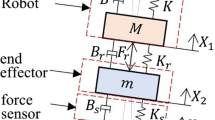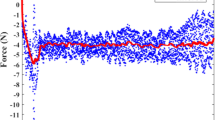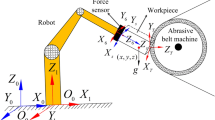Abstract
The aero-engine blade grinding system has time delay problem, which leads to large fluctuation of grinding force and eventually affects the surface roughness of the blade. To address this problem, this paper combines the improved Smith prediction algorithm with active disturbance rejection control (ADRC) to propose the filter Smith-ADRC control algorithm, which consists of three parts, namely, the main controller, the compensator and the filter. It is firstly simulated and analyzed in Matlab/Simulink platform, and then the robot grinding system is constructed for experimental verification, which is executed by the robot for position control and by the end-effector for force control. Both simulation and experimental results show that the grinding system with filter Smith-ADRC controller has good control effect and stability. The surface roughness of the blade is 0.3503 μm after grinding, which is better than other control algorithms such as ADRC and Smith’s predictive control. Consequently, the filter Smith-ADRC control algorithm can overcome the time delay problem of the system and improve the grinding accuracy and quality.
























Similar content being viewed by others
Data availability
Available on request.
Code availability
The codes that support the findings of this study are available from corresponding author upon reasonable request.
References
Ke XL, Yu YH, Li KS, Wang TY, Zhong B, Wang ZZ (2023) Review on robot-assisted polishing: Status and future trends. Robot Comput-Integr Manuf 80:102482. https://doi.org/10.1016/j.rcim.2022.102482
Wang GL, Deng YX, Zhou HB, Yue X (2023) PD-adaptive variable impedance constant force control of macro-mini robot for compliant grinding and polishing. Int J Adv Manuf Technol 124:2149–2170. https://doi.org/10.1007/s00170-022-10405-x
Tian FJ, Li ZG, Lv C, Liu GB (2016) Polishing pressure investigations of robot automatic polishing on curved surfaces. Int J Adv Manuf Technol 87:639–646. https://doi.org/10.1007/s00170-016-8527-2
Dong JL, Shi JS, Liu C, Yu TB (2021) Research of Pneumatic Polishing Force Control System Based on High Speed On/off with PWM Controlling. Robot Comput-Integr Manuf 70:102133. https://doi.org/10.1016/j.rcim.2021.102133
Roveda L, Pallucca G, Pedrocchi N, Braghin F, Tosatti LM (2017) Iterative Learning Procedure with Reinforcement for High-Accuracy Force Tracking in Robotized Tasks. IEEE Trans Industr Inform 14(4):1753–1763. https://doi.org/10.1109/TII.2017.2748236
Lin B, Jiang XM, Cao ZC, Huang T (2019) Development and theoretical analysis of novel center-inlet computer-controlled polishing process for high-efficiency polishing of optical surfaces. Robot Comput-Integr Manuf 59:1–12. https://doi.org/10.1016/j.rcim.2019.01.017
Lakshminarayanan S, Kana S, Mohan DM, Manyar OM, Then D, Campolo D (2020) An adaptive framework for robotic polishing based on impedance control. Int J Adv Manuf Technol 112(1–2):401–417. https://doi.org/10.1007/s00170-020-06270-1
Wei YZ, Xu QS (2022) Design of a new passive end-effector based on constant-force mechanism for robotic polishing. Robot Comput-Integr Manuf 74:7102278. https://doi.org/10.1016/j.rcim.2021.102278
Wang QL, Wang W, Zheng LY, Yun C (2021) Force control-based vibration suppression in robotic grinding of large thin-wall shells. Robot Comput-Integr Manuf 67:102031. https://doi.org/10.1016/j.rcim.2020.102031
Xu XH, Chen W, Zhu DH, Yan SJ, Ding H (2021) Hybrid active/passive force control strategy for grinding marks suppression and profile accuracy enhancement in robotic belt grinding of turbine blade. Robot Comput-Integr Manuf 67:102047. https://doi.org/10.1016/j.rcim.2020.102047
Mohammad AEK, Hong J, Wang DW (2018) Design of a force-controlled end-effector with low-inertia effect for robotic polishing using macro-mini robot approach. Robot Comput-Integr Manuf 49:54–56. https://doi.org/10.1016/j.rcim.2017.05.011
Xu XH, Zhu DH, Zhang HY, Yan SJ, Ding H (2019) Application of novel force control strategies to enhance robotic abrasive belt grinding quality of aero-engine blades. Chin J Aeronaut 32(10):2368–2382. https://doi.org/10.1016/j.cja.2019.01.023
Califano C, Moog CH (2017) Accessibility of Nonlinear Time-Delay Systems. IEEE Trans Automat Contr 62(3):1254–1268. https://doi.org/10.1109/tac.2016.2581701
Lu JQ, Jiang BX, Zheng WX (2022) Potential Impacts of Delay on Stability of Impulsive Control Systems. IEEE Trans Automat Contr 67(10):5179–5190. https://doi.org/10.1109/tac.2021.3120672
Meng QT, Ma Q, Zhou GP (2022) Adaptive Output Feedback Control for Stochastic Uncertain Nonlinear Time-Delay Systems. IEEE Trans Circuits Syst II Express Briefs 69(7):3289–3293. https://doi.org/10.1109/tcsii.2022.3152523
Zheng YD (2021) Adaptive control for time-delay systems adopting Smith predictor models. Control Theory Appl 38(3):416–424 (https://doi.org/CSCD:6944172)
Sun Y, Lu Z, Li P (2015) Complex time-delay dynamical systems of quadratic polynomials mapping. Nonlinear Dynam 79(1):369–375. https://doi.org/10.1007/s11071-014-1670-0
Wang W, Liu MH, Zeng HB (2022) Stability analysis of time-delay systems via a delay-derivative-partitioning approach. IEEE Access 10:99330–99336. https://doi.org/10.1109/access.2022.3206959
Liu T, Garcia P, Chen YL, Ren XH, Albertos P, Sanz R (2018) New predictor and 2DOF control scheme for industrial processes with long time delay. IEEE Trans Ind Electron 65(5):4247–4256. https://doi.org/10.1109/TIE.2017.2760839
Lee SM, Shin M, Son H (2023) Robust predictor-based control for multirotor UAV with various time delays. IEEE Trans Ind Electron 70(8):8151–8162. https://doi.org/10.1109/TIE.2022.3224130
Zhao XH, Chen SZ, Jing LT, Wang X (2023) H8 robust control for underwater supercavitating vehicle with time delay. J Vib Control. https://doi.org/10.1177/10775463231189555
Ma XY, Zhang QZ, Liu JK, Xing XY (2023) Predictive disturbance-observer-based controller design for a class of input time-delay mechanical systems with input constraints. Int J Control. https://doi.org/10.1080/00207179.2023.2235445
Jugo J, Elejaga A, Echevarria P (2023) Modified active disturbance rejection control scheme for systems with time delay. Iet Control Theory A. https://doi.org/10.1049/cth2.12515
Baneshi F, Ghaffari V (2022) Designing of a non-fragile robust predictive controller for uncertain systems with time-varying delay: A delay-range-dependent approach. Iet Control Theory A 16(8):762–775. https://doi.org/10.1049/cth2.12268
Qin WW, Bing H, Gang L, Zhao PT (2016) Robust model predictive tracking control of hypersonic vehicles in the presence of actuator constraints and input delays. J Franklin I 353(17):4351–4367. https://doi.org/10.1016/j.jfranklin.2016.08.007
Sakthivel R, Harshavarthini S, Mohanapriya S, Almakhles DJ, Kavikumar R (2023) Disturbance rejection based tracking control design for fuzzy switched systems with time-varying delays and disturbances. Int J Robust Nonlin 33(2):1184–1202. https://doi.org/10.1002/rnc.6419
Feliu-Batlle V, Rivas-Perez R (2021) Control of the temperature in a petroleum refinery heating furnace based on a robust modified Smith predictor. Isa T 112:251–270. https://doi.org/10.1016/j.isatra.2020.12.006
Ghorbani M, Tavakoli-Kakhki M, Tepljakov A, Petlenkov E (2023) Robust stability analysis of smith predictor based interval fractional-order control systems: A case study in level control process. Ieee-Caa J Automatic 10(3):762–780. https://doi.org/10.1109/jas.2022.105986
Huang HC, Zhang SQ, Yang Z, Tian YQ (2018) Modified Smith fuzzy PID temperature control in an oil-replenishing device for deep-sea hydraulic system. Ocean Eng 149:14–22. https://doi.org/10.1016/j.oceaneng.2017.11.052
Sindhuja PP, Vijayan V, Panda RC (2023) Control of time-delay systems through modified Smith predictor using sliding mode controller. Int J Syst Sci 1–26. https://doi.org/10.1080/00207721.2023.2210151
Ranjan A, Mehta U (2023) Improved control of integrating cascade processes with time delays using fractional-order internal model controller with the Smith predictor. P I Mech Eng I-J Sys. https://doi.org/10.1177/09596518231168510
Sakthivel R, Shobana N, Priyanka S, Kwon OM (2023) State observer-based predictive proportional-integral tracking control for fuzzy input time-delay systems. Int J Robust Nonlinear Control 33(11):6052–6069. https://doi.org/10.1002/rnc.6681
Lima DM, Lima BM, Normey-Rico JE (2023) A predictor for square multivariable dead-time systems with multiple delays based on the Kalman filter. J Process Control 124:105–117. https://doi.org/10.1016/j.jprocont.2023.02.016
Dogruer T (2023) Design of I-PD controller based modified smith predictor for processes with inverse response and time delay using equilibrium optimizer. IEEE Access 11:14636–14646. https://doi.org/10.1109/access.2023.3244328
Yegin MO, Ozbay H (2023) On Smith predictor based controllers for plants with time delay and multiple unstable modes. Syst Control Lett 172:105453. https://doi.org/10.1016/j.sysconle.2022.105453
Ba DJ, Chen GW, Li P, An KX, Liu XB (2023) Fuzzy Smith predictor-based active disturbance rejection controller for time-delay systems with application to drilling stick-slip vibration control. P I Mech Eng I-J Sys 237(3):401–414. https://doi.org/10.1177/09596518221134136
Zheng YD (2022) Research of lyapunov-theory-based adaptive control improving on smith predictor methods in time-delay systems. Int J Control Autom 20(10):3177–3186. https://doi.org/10.1007/s12555-021-0354-z
Mohanapriya S, Sakthivel R, Almakhles DJ (2022) Design of robust tracking and disturbance attenuation control for stochastic control systems. Isa T 129:110–120. https://doi.org/10.1016/j.isatra.2022.01.034
Huang T, Sun LN, Wang ZH, Yu XY, Chen GD (2017) Hybrid force/position control method for robotic polishing based on passive compliance structure. Robot 39(6):776–785. https://doi.org/10.13973/j.cnki.robot.2017.0776
Jq HAN (2009) From PID to active disturbance rejection control. Ieee T Ind Electron 56(3):900–906. https://doi.org/10.1109/TIE.2008.2011621
Zhang LJ, Hu RQ, Yi WM (2017) Research on force sensing for the end-load of industrial robot based on a 6-axis force/torque sensor. Acta Autom Sin 43(3):439–447. https://doi.org/10.16383/j.aas.2017.c150753
Tian G, Gao ZQ (2007) Frequency response analysis of active disturbance rejection based control system. IEEE Int Conf Control Appl. Singapore 1595–1599. https://doi.org/10.1109/CCA.2007.4389465
Nakayama H, Ishida Y, Matsumoto N (2018) Filtered Smith predictor using disturbance compensator for first and second-order plants with time-delay. 2018 9th IEEE Control and System Graduate Research Colloquium (ICSGRC). Shah Alam, Malaysia 132–135. https://doi.org/10.1109/ICSGRC.2018.8657588
Yao DY, Li HY, Lu RQ, Shi Y (2020) Distributed sliding-mode tracking control of second-order nonlinear multiagent systems: an event-triggered approach. IEEE T Cybern 50(9):3892–3902. https://doi.org/10.1109/TCYB.2019.2963087
Wang S, Cao YT, Huang TW, Chen YR, Li P, Wen SP (2020) Sliding mode control of neural networks via continuous or periodic sampling event-triggering algorithm. Neural Netw 121:140–147. https://doi.org/10.1016/j.neunet.2019.09.001
Funding
This work is jointly funded by National Key Research and Development Program of China (Grant numbers 2019YFB1311104) and Hebei Province Graduate Innovation Funding Project (Grant numbers CXZZSS2023023).
Author information
Authors and Affiliations
Contributions
All authors contributed to the study conception and design. Kailiang Shen: Conceptualization, Methodology; Writing—original draft; Shijie Dai: Resources, Validation, Supervision; Wenbin Ji: Writing—review & editing; Ruiqin Wang: Investigation, Supervision. All authors read and approved the final manuscript.
Corresponding author
Ethics declarations
Ethics approval
Not applicable.
Consent to participate
All authors agree to participate.
Consent for publication
All authors agree to publish.
Conflicts of interest/Competing interests
The authors have no conflicts or competing interests.
Additional information
Publisher's Note
Springer Nature remains neutral with regard to jurisdictional claims in published maps and institutional affiliations.
Rights and permissions
Springer Nature or its licensor (e.g. a society or other partner) holds exclusive rights to this article under a publishing agreement with the author(s) or other rightsholder(s); author self-archiving of the accepted manuscript version of this article is solely governed by the terms of such publishing agreement and applicable law.
About this article
Cite this article
Shen, K., Dai, S., Ji, W. et al. Study on the constant force control of aero-engine blade grinding robot considering time delay. Int J Adv Manuf Technol 131, 1427–1447 (2024). https://doi.org/10.1007/s00170-024-13029-5
Received:
Accepted:
Published:
Issue Date:
DOI: https://doi.org/10.1007/s00170-024-13029-5




